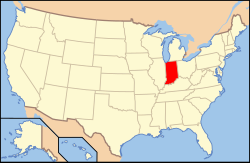Indiana wine
Appearance
| Wine region | |
 | |
| Official name | State of Indiana |
|---|---|
| Type | U.S. state |
| Year established | 1816 |
| Country | United States |
| Sub-regions | Indiana Uplands AVA |
| Climate region | Continental/humid subtropical |
| Total area | 36,418 square miles (94,322 km2)[1] |
| Size of planted vineyards | 270 acres (109 ha)[1] |
| No. of vineyards | 30[1] |
| Grapes produced | Aurore, Baco noir, Cabernet Franc, Cabernet Sauvignon, Catawba, Cayuga, Chambourcin, Chardonel, Chardonnay, Concord, Geisenheim, Gewürztraminer, Leon Millot, Marechal Foch, Merlot, Muscat Canelli, Niagara, Pinot gris, Pinot noir, Riesling, Sauvignon blanc, Seyval blanc, St. Vincent, Steuben, Traminette, Vidal blanc, Vignoles, Villard blanc, Viognier[1] |
Indiana wine is wine made from grapes grown in the U.S. state of Indiana. Wine has been produced in the area since the early days of European colonization in the 18th century. In the mid-19th century, Indiana was the tenth-largest winegrape producing state in the country.
There are two American Viticultural Areas (AVA) in Indiana: the Ohio River Valley AVA which also contains portions of Kentucky and Ohio, and the Indiana Uplands AVA which is wholly located in south-central Indiana and includes the oldest and most prolific winery in Indiana, Oliver Winery.
References
[edit]- ^ a b c d "Indiana: Appellation Profile". Archived from the original on September 3, 2013. Retrieved November 16, 2007.

